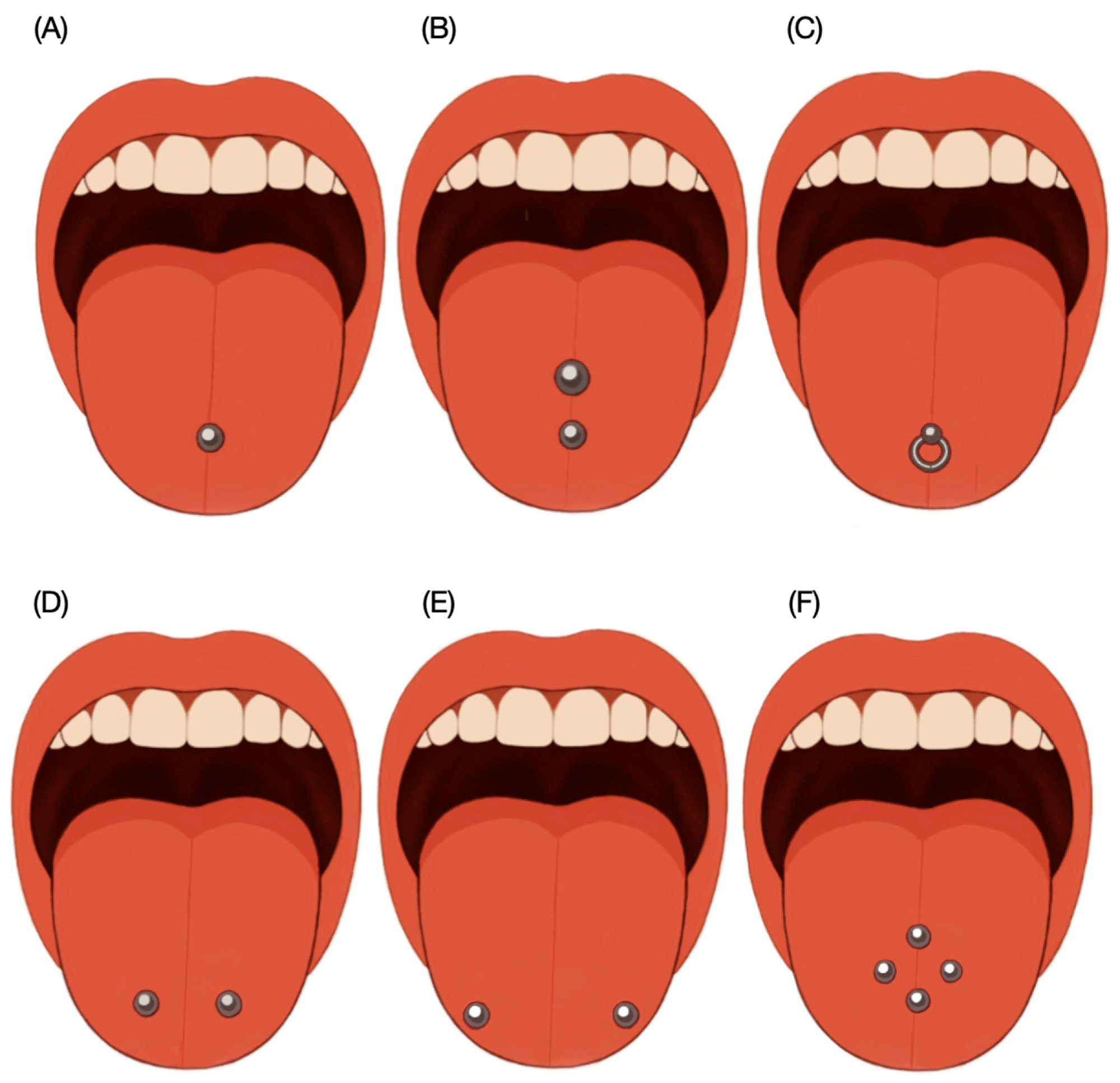A new review warns that tongue piercings can damage teeth, gums, and even pose rare but serious systemic risks, urging patients and clinicians to weigh the dangers carefully.

Schematic diagram illustrating the most common sites for tongue piercings. (A) Single middle tongue; (B) double piercing in midline; (C) ring piercing; (D,E) double piercing horizontally and (F) multiple piercing usually involving two or more piercings arranged in a row or symmetrically on either side of the midline.
In a recent review article published in the journal Clinics and Practice, researchers examined the oral health implications of tongue piercings.
Body piercing involves inserting jewelry into openings created in body parts, including the ears, lips, eyebrows, nose, nipples, intimate areas, and tongue. This practice has increasingly become popular in Western societies over the past decades, and is carried out in both unregulated and regulated environments. As such, sterilization methods and hygiene levels can vary based on the practitioner and location.
As the trend continues, there is a need for more stringent regulations, improved practices, and greater public awareness to ensure the well-being and safety of people engaging in body piercings.
Studies highlight several intraoral piercing sites, including the lips, tongue, labial frenulum, cheek, lingual frenulum, and uvula.
Tongue piercings are among the most popular forms, especially among young adults and teenagers. A tongue piercing is usually performed without anesthesia; healing typically takes around three to five weeks.
While tongue piercings are increasingly adopted in modern culture, it is critical to consider the related risks, such as allergic reactions, dental complications, and infections. Tongue piercings are linked to adverse health effects.
Common complications include swelling, pain, bleeding, lesions, gingival recession, and infection. In addition, oral microflora alterations, salivary composition changes, dental damage, and compromised periodontal health have been documented. Beyond local complications, tongue piercings may be potential vectors for viral transmission (including HIV, HBV, HCV, HSV, and EBV).
The review and findings
In the present review, researchers explored the impact of tongue piercings on oral health, focusing on the adverse effects of their use. They searched the Web of Science, Scopus, PubMed, and Google Scholar databases for relevant articles on tongue/oral piercings published from January 1990 to March 2025. Peer-reviewed studies explicitly addressing oral health consequences of tongue piercings were eligible, including case reports, observational studies, and reviews.
The search procedure yielded 257 articles; 19 publications were selected for analysis. These included five literature reviews and 14 clinical reports and case studies. These studies identified various sites for tongue piercings, including vertical, double, ring, double lateral, horizontal, and multiple piercings.
The vertical piercing features a barbell positioned at the center of the tongue. The ring piercing is also placed at the center of the tongue. The double piercing features two piercings along the midline of the tongue. The horizontal piercing runs through the tip with ball ends on each side. The double lateral piercing comprises two studs parallel to each other on either side. Multiple piercings involve ≥ two piercings arranged systematically or in a row on either side of the midline.
Literature reviews evaluated clinical outcomes and risks associated with tongue piercings. For instance, one review reported increased enamel fractures, gingival recession, and enamel fissures associated with tongue piercings.
Similarly, another review indicated that oral piercings pose hazardous risks to the hard and soft oral and perioral tissues and that piercings may even pose life-threatening risks.
Another review suggested that rare but serious systemic infections, such as infective endocarditis, may occur, although their prevalence remains low. Meanwhile, case studies and clinical reports provided insights into the specific oral health complications, such as gingival recession, tooth fractures, mucosal lesions, soft tissue trauma, and infections.
One case study reported severe pain and a lesion in a female with a barbell-shaped piercing, which healed a week after piercing removal.
Another study described a 15 mm-wide midline nodule on the dorsal tongue in a female with a piercing in the same site that was removed two years prior. In a case report, a male with a tongue ornament developed an infection in the area that healed over, resulting in a division of the tongue at the midline or anterior aspect.
One study reported complications, including bleeding, embedded ornaments, and infection, in three cases.
Conclusions
In sum, tongue piercings pose significant health risks, with complications like swelling, pain, tooth fractures, gum recession, speech difficulties, and infections. Although rare, severe conditions like infective endocarditis and nerve damage may also occur.
The evidence base is limited, since most available studies are case reports and small clinical series, and this review was narrative in nature without formal quality assessment.
These limitations mean the strength of evidence is relatively low, and conclusions should be interpreted with caution. People must reconsider tongue piercings in favor of safer alternatives.
In cases where they still proceed with this oral piercing, they should be fully informed of the potential risks associated with it. Clinicians must remain vigilant and educate patients about the complications associated with tongue piercings. They must be prepared to prevent, monitor, and manage related problems in clinical practice.
Journal reference:
- Rojas-Rueda S, Citrin NS, Antal MA, Garcia-Contreras R, Jurado CA, Azpiazu-Flores FX (2025). Impact of Tongue Piercings on Oral Health: A Narrative Literature Review. Clinics and Practice, 15(9), 171. DOI: 10.3390/clinpract15090171, https://www.mdpi.com/2039-7283/15/9/171